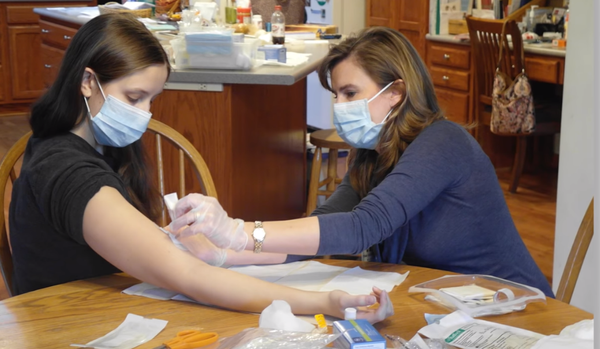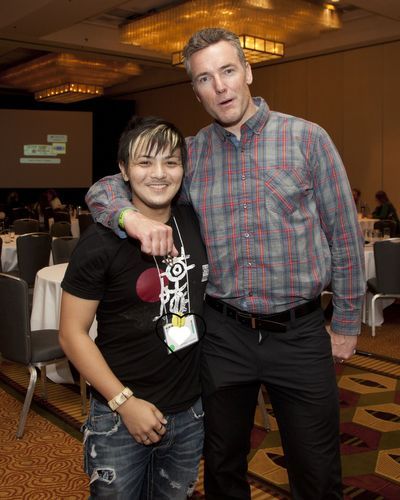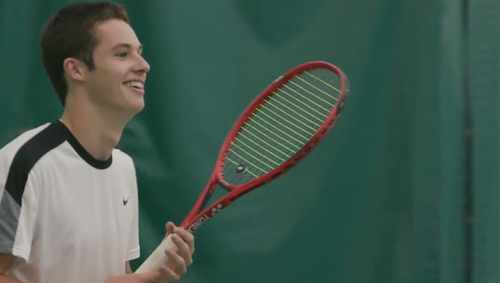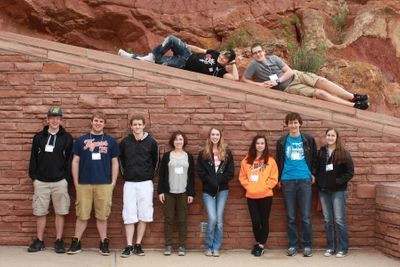WHY DID MY CHILD GET PSC?

Currently, no one knows the exact cause of PSC. We do know that:
- There appear to be genetic, environmental, and autoimmune components to PSC.
- PSC usually co-exists with inflammatory bowel disease (IBD), most often ulcerative colitis and sometimes Crohn’s disease, and the combined occurrence of PSC and IBD is found in approximately 80% of pediatric PSC patients.
- There is no clear correlation between the severity and onset of PSC and IBD, and both diseases can run separate clinical courses.
- IBD may be diagnosed before, at the same time, or after the diagnosis of PSC. Sometimes there are no IBD symptoms, yet colonoscopy and biopsy may show microscopic inflammation of the colon.
- Families with IBD have a higher chance of having a child with PSC. Additionally, having a first-degree relative with PSC increases the risk for PSC at least four-fold, although the overall absolute risk is still very low.
- As a parent, there is nothing you could have done differently to prevent PSC in your child.
What is PSC?
PSC is a rare disease of the bile ducts.
Primary sclerosing cholangitis (PSC) is a rare, chronic disease of inflammation and scarring that affects the bile ducts outside and/or inside the liver. The liver makes bile that is carried by bile ducts to the small intestine. Bile is important for the absorption of fats and vitamins A, D, E, and K. With a PSC patient, bile sometimes can't get to the intestines and stays in the liver where it damages liver cells, leading to scarring and, possibly, cirrhosis. Although cirrhosis may take years to occur, it may occur sooner in some individuals, and may never occur in others.
Medical Terms: Check out this page for an explanation of medical terms associated with PSC and PSC-related diseases.
WHAT ARE THE COMMON SYMPTOMS OF PSC?
Many children with PSC are in early stages of the disease process and have no symptoms.
Blood tests or imaging may identify an abnormal biliary system in the liver. Over time, symptoms associated with poor bile flow and liver disease may develop. These include:
- Intense persistent itching, called pruritus
- Fatigue
- Pain on right side of the abdomen, possibly extending around the back, or in upper middle of abdomen
- Jaundice and icterus (yellowing of the skin and eyes, respectively)
- Diarrhea
- Weight loss
- Poor growth
- Abnormal liver blood tests
- Hepatomegaly (an enlarged liver)
- Splenomegaly (an enlarged spleen)
- Chills and fever: signs of bacterial infection in bile ducts requiring immediate medical attention
Signs that PSC has progressed to cirrhosis and that further treatments, including liver transplantation, may be indicated, include:
- Easy bruising and bleeding
- Ascites: build up of fluid in the abdomen
- Hepatic encephalopathy: reduced attention, forgetfulness, confusion, or slurred speech due to liver dysfunction
- Varices: swollen veins in the gastrointestinal tract, most often esophagus and stomach, that are prone to bleeding
Most children with PSC have inflammatory bowel disease (Crohn’s disease or ulcerative colitis), which may present with:
- Chronic diarrhea
- Blood in the stool
- Poor growth
- Abdominal pain
HOW IS PEDIATRIC PSC DIAGNOSED?

Most PSC cases in children are diagnosed early. Diagnosis is made in the following ways:
PSC is suspected when liver blood tests are abnormal, especially in a child known to have inflammatory bowel disease (IBD), either ulcerative colitis or Crohn's disease, and/or autoimmune hepatitis (AIH).
PSC is confirmed when scarring, dilation, and irregularity of the bile ducts are observed on imaging tests or liver biopsy.
Blood tests for PSC include:
- Conjugated or direct bilirubin
- Gamma-glutamyltranspeptidase (GGT)
- Alanine aminotransferase (ALT)
- Aspartate aminotransferase (AST)
Children with advanced disease may have:
- anemia (low hemoglobin)
- low platelet count
- prolonged time to clot blood (an elevated INR)
Imaging tests include:
- Magnetic Resonance Cholangiopancreatography (MRCP), which is noninvasive, has no radiation exposure, and is a first-line test
- Endoscopic Retrograde Cholangiopancreatography (ERCP) is a procedure performed under anesthesia using a camera scope inserted into the mouth to inject dye into the bile ducts while x-rays are being taken
- When imaging tests are abnormal, a patient has “large duct” PSC
- Ultrasound and Computed Tomography (CT scan) are sometimes performed but cannot be used to diagnose PSC
- Most children need a liver biopsy to exclude or "rule out" autoimmune hepatitis (AIH), a common additional liver inflammation problem that can occur with PSC
- Some PSC patients have disease only in the smallest bile ducts within the liver
- If imaging is normal but PSC is still suspected, a liver biopsy may be done, which can identify “small duct” PSC
HOW DOES PSC IN CHILDREN DIFFER FROM ADULT PSC?

PSC is 10-20 times less common in children than in adults.
- Almost half of children have another liver problem called autoimmune hepatitis (AIH) in addition to PSC, compared to only 4% of adults
- Children do not generally have serious bile duct strictures or cancers at the time of diagnosis. Adults may have these problems when diagnosed.
- Overall, children tend to present with milder disease, but, as they grow older, their disease and its complications present more like adult PSC
- Every child is different, and some progress to cirrhosis or to significant obstruction of the bile ducts before adulthood
- Special considerations must be given to maintain normal nutrition, growth and maturity in children with PSC, especially if the child has ulcerative colitis or Crohn's disease
WHAT IS SMALL DUCT PSC?
Small duct PSC is PSC that affects only the small bile ducts within the liver and not the large ducts outside the liver.
- In small duct PSC, liver imaging, including MRCP and ERCP, may be normal
- Diagnosis is typically made with liver biopsy
- Liver scarring usually develops more slowly in small duct PSC compared to PSC involving bile ducts both inside and outside the liver
HOW WILL PSC AFFECT THE LIFE OF MY CHILD?

The majority of children with PSC can have a normal quality of life, and may not experience any liver-related symptoms or pain. Most are able to participate in desired activities.
- If and when the spleen becomes enlarged, there may be some physical activity limitations, such as avoidance of contact sports
- Issues regarding activities and lifestyle should be discussed with your child’s hepatologist/gastroenterologist
- Children with progressive disease may require more frequent monitoring, clinic visits, hospital admissions, and occasionally liver transplantation
WHEN SHOULD I TAKE MY CHILD TO THE HOSPITAL?

Some PSC symptoms, which may require immediate medical attention, include:
- Fever, chills, and jaundice are signs of bacterial infection in bile ducts.
- Vomiting blood, or seeing either red blood or dark black blood in the stool are signs of burst blood vessels, called varices, in the esophagus and stomach.
- Any time your child experiences fever or chills, significant right upper quadrant abdominal pain, or rapidly progressive jaundice, they should be examined by a doctor to rule out infection of the bile ducts, known as acute bacterial cholangitis. The diagnosis of acute cholangitis often requires blood tests, a blood culture, and an imaging test. Antibiotic therapy may be given.
- New jaundice, darkening urine, pale stools, or unexplained persistent abdominal pain also should be reported to your child’s gastroenterologist/hepatologist.
HOW DO I FIND THE RIGHT SPECIALIST FOR MY CHILD?
Pediatric PSC patients are usually cared for by a pediatrician specially trained in childhood liver disease, i.e. a pediatric hepatologist. Here are some tips:
- Many pediatric gastroenterologists who care for pediatric IBD also are trained to care for patients with PSC, often in collaboration with a pediatric hepatologist
- Many larger pediatric medical centers have gastroenterology and hepatology programs, as well as an active liver transplantation program, to provide comprehensive care to children with PSC
- Most physicians and medical centers that are involved in PSC collaborative research studies on childhood PSC and other liver diseases provide excellent care for pediatric PSC patients
- The PSC Partners Patient Registry has a list of hepatologists consulted by PSC patients. If you join the registry, you can see the list by clicking on healthcare providers at www.pscpartners.org/patient-registry.
- Check the Clinical Trials website to see participating physicians and centers
HOW CAN PSC PARTNERS SEEKING A CURE HELP ME?

Your child and your family may benefit from support groups and counseling, as dealing with a new diagnosis of a chronic disease may be challenging for children and adolescents. Here are some ways PSC Partners can help:
- Annual Conference: Each year, PSC Partners Seeking a Cure holds an Annual Conference in a different medical center in the United States that treats and researches PSC. The conferences provide education and support for patients and caregivers, as well as updates on recent research developments. The conference offers a pediatric track that includes presentations by pediatric specialists, interactive sessions for parents, and social activities for teens with PSC. Conference attendees regularly describe the conference as “family reunions,” and attendees highly value the experience of networking with a community of people who understand what is involved in coping with and treating PSC. Because PSC is rare, the support and understanding of our community is an invaluable resource for patients and their caregivers alike. Pediatric parents value the support of other parents. The teens with PSC are welcomed by others with PSC. The minimum age for attending the conference is 13, due to the nature of the conference sessions.
- Mentors: We provide an individual mentor program for caregivers and teens. If you’re interested in having a mentor, please send us an email or give us a call. Visit the Contact Us page on this site.
- Facebook: The PSC community gathers on the PSC Partners public and private Facebook sites where every question gets multiple responses. Find us on Facebook at PSC Partners Seeking a Cure.
- Twitter: We are on Twitter @PSCPartners.
- Instagram: We are on Instagram @psc.partners.
- YouTube: Our channel is PartnersSeekingaCure.
- LinkedIn: We are PSC Partners Seeking a Cure.
- Website: More information about PSC, the PSC community, and PSC-related events can be found on this website .
- Patient Registry: Parents can participate in the PSC Partners Patient Registry by enrolling their child. Here’s your chance to help speed up PSC research. Everyone's participation is important. The larger the PSC Patient Registry is, the more meaningful it can be for researchers from around the world. All data in the Patient Registry is de-identified. If your child's profile matches the requirements set by a study or clinical trial, you can opt in to be contacted by the registry coordinator. If interested, it would then be up to you to contact the researcher(s). Click on the link at the bottom of this page for more information and to register. If you need assistance, a PSC Patient Registry staff member can assist you.
- Literature: For medical information on PSC and related diseases, please visit our PSC Partners web resource page, which includes a link to the PSC literature page that is updated as new studies are published.

Would you be interested in taking brochures to your doctors and medical centers? You will find the abbreviated version of this document in our Pediatric PSC brochure here, or you can ask us to send you brochures.
Feel free to contact us and learn more about the many ways that PSC Partners can help you and your child navigate life with PSC.
Complete your profile and join PSC Partners Seeking a Cure in advancing PSC research towards a cure. Find information about clinical trials.






